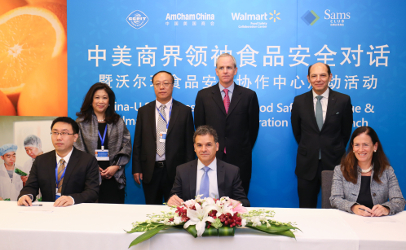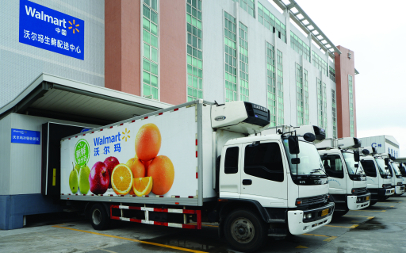Editor’s note: Depending on which hemisphere you are in while reading this column by Wal-Mart Vice President for Food Safety Frank Yiannas, the retailer’s new Food Safety Collaboration Center is opening today or tomorrow (March 29) in Beijing, China.
The food system has been changing since the dawn of time, but never more rapidly or dramatically as it has the potential to do so today. After countless millennia as hunter-gatherers and subsistence farmers and a century or so of industrial farming and modern retail, we are now entering a new era.

Today, whether we live in Shenzhen, Santiago, Sheffield or Chicago, we shop at modern retail stores with tens of thousands of products on the shelves. We fill our shopping baskets with fresh and frozen foods without regard for the season. We can choose to buy local or enjoy the best products from the best producers anywhere in the world. We go online and get whatever we want delivered direct to our door or local store.
This choice, affordability, and convenience is the result of many extensive developments throughout the food supply chain, but one development stands out to me as the most inspiring and impactful. It’s not a technology or a business model: not the Internet of Things or mobile commerce or globalization. Nor is it a new idea; it’s one our hungry cave-dwelling ancestors knew and understood. It’s called “collaboration.”
Food safety without borders
I’ve been in the food industry for more than 30 years and I work for the world’s largest retailer. With operations in 28 countries, selling fresh groceries and food items both in-store and online, we work with food producers, regulators, academic institutions, transportation companies, and others within and between countries the world over.
As food industry professionals, we know that hazards in the food supply don’t recognize borders or boundaries, so we can’t limit our food safety systems in this way either. As long as foodborne disease exists somewhere in the world, it can exist anywhere in the world. And when others win battles against foodborne disease, we all win.
Regulators in China, Europe, the United States and elsewhere are now collaborating to create better food safety laws and regulations, and private sector companies are increasingly sharing food safety best practices. But we need to do much more than this.

An idea born in China
Last year, we announced the Wal-Mart Food Safety Collaboration Center in China and called for partners in the food system to participate. Our aim is to help accelerate the development and adoption of food safety solutions that can be openly shared and scaled throughout the supply chain. We will bring together Chinese and international expertise to help identify food safety issues in China and to find practical solutions to these challenges. Wal-Mart and the Wal-Mart Foundation plan to invest $25 million over five years on projects to advance food safety in China.
The center will open its office March 29, when it will host the first meeting of its international board of experts and set its plans for the year. It has already received overwhelming support from government officials, industry associations, academia and businesses in China and the U.S.
For the center to succeed, these parties will need to work together. But to achieve the broader aim of safer food for everyone, something that is much more difficult needs to be achieved: industry-wide collaboration. This means nothing less than transparency and trust that scales across the farm-to-fork supply chain.
Building with blockchain
One of the first projects to come out of the Wal-Mart Food Safety Collaboration Center addresses this. It is a blockchain pilot being driven jointly by IBM, suppliers and Tsinghua University. Blockchain is the technology behind cyber-currencies like Bitcoin. It creates a digital, permanent ledger that links blocks of data together in an unbroken chain, allowing unrelated stakeholders to jointly keep a secure and reliable record of important data attributes and transactions. No one can change or remove the data, and it’s not centralized; everyone has access to it.
Our blockchain pilot test in China is starting with pork and tracing it from farm to table.
This technology could enable me, as the retailer, to be able to digitally track individual pork products in minutes, not days. I’ll know the farm, the factory, the batch number, storage temperature and shipping details. I’ll be able to tell if this product is authentic and safe, and when it expires. If a food contamination issue arises at the farm or factory, I’ll know which products to recall, and which may be left on the shelves.

21st Century transparency
China’s situation may seem unique. After all, it’s facing rapid economic growth and urbanization, as well as considerable changes to food consumption habits. It has traditional agricultural practices alongside modern farms, and traditional wet markets as well as modern supermarkets. Transportation and logistics are developing rapidly, with efficient urban infrastructure but underserved and remote rural districts.
Even so, it’s clear that today’s food system is more global and interconnected than ever. Markets as diverse as China, Chile, the UK and the U.S. are actually more alike than they seem at first glance.
When I sit down to enjoy one of my favorite desserts, tiramisu, I know that that I am looking at a multitude of ingredients, sourced from all over the world: cream from the U.S., chocolate from Belgium, vanilla from Madagascar, coffee beans from Colombia. My tiramisu may appear simple yet is made up of some of the world’s finest ingredients, and I care about the quality of every one.
Now imagine there’s a global recall of a certain brand of chocolate. As a consumer, I’d like to know that the chocolate in my tiramisu is not involved. As the food producer or retailer, I want this information too, and I need it immediately to minimize the impact on my business.
Blockchain technology has the potential to provide this level of traceability as part of a digitized food system. It can also take us beyond traceability to transparency, where we have a complete and interconnected view of the supply chain. We hope this will lead to new insights that can further improve supply chain efficiencies, promote sustainability, and reduce food waste.
Transparency will be a game changer in the world of food safety in the 21st Century. It’s technically possible today and, with China on the leading edge of this shift, it’s closer than you might think.
 Note on author: Frank Yiannas is vice president of food Safety at Wal-Mart. Yiannas is the past president of the International Association for Food Protection (IAFP) and recipient of the 2007 NSF Lifetime Achievement Award for Leadership in Food Safety. Yiannas is the author of two books: “Food Safety=Behavior” published in 2015 and “Food Safety Culture” published 2008.
Note on author: Frank Yiannas is vice president of food Safety at Wal-Mart. Yiannas is the past president of the International Association for Food Protection (IAFP) and recipient of the 2007 NSF Lifetime Achievement Award for Leadership in Food Safety. Yiannas is the author of two books: “Food Safety=Behavior” published in 2015 and “Food Safety Culture” published 2008.
(To sign up for a free subscription to Food Safety News, click here.)
